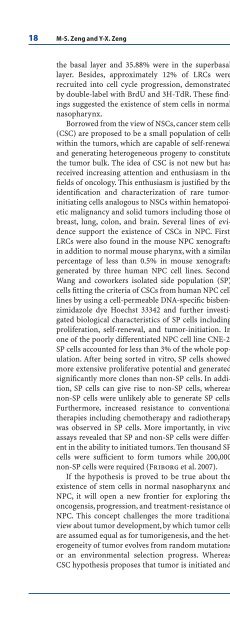Familial Nasopharyngeal Carcinoma 6
Familial Nasopharyngeal Carcinoma 6
Familial Nasopharyngeal Carcinoma 6
- No tags were found...
Create successful ePaper yourself
Turn your PDF publications into a flip-book with our unique Google optimized e-Paper software.
18 M-S. Zeng and Y-X. Zengthe basal layer and 35.88% were in the superbasallayer. Besides, approximately 12% of LRCs wererecruited into cell cycle progression, demonstratedby double-label with BrdU and 3H-TdR. These findingssuggested the existence of stem cells in normalnasopharynx.Borrowed from the view of NSCs, cancer stem cells(CSC) are proposed to be a small population of cellswithin the tumors, which are capable of self-renewaland generating heterogeneous progeny to constitutethe tumor bulk. The idea of CSC is not new but hasreceived increasing attention and enthusiasm in thefields of oncology. This enthusiasm is justified by theidentification and characterization of rare tumorinitiatingcells analogous to NSCs within hematopoieticmalignancy and solid tumors including those ofbreast, lung, colon, and brain. Several lines of evidencesupport the existence of CSCs in NPC. First,LRCs were also found in the mouse NPC xenograftsin addition to normal mouse pharynx, with a similarpercentage of less than 0.5% in mouse xenograftsgenerated by three human NPC cell lines. Second,Wang and coworkers isolated side population (SP)cells fitting the criteria of CSCs from human NPC celllines by using a cell-permeable DNA-specific bisbenzimidazoledye Hoechst 33342 and further investigatedbiological characteristics of SP cells includingproliferation, self-renewal, and tumor- initiation. Inone of the poorly differentiated NPC cell line CNE-2,SP cells accounted for less than 3% of the whole population.After being sorted in vitro, SP cells showedmore extensive proliferative potential and generatedsignificantly more clones than non-SP cells. In addition,SP cells can give rise to non-SP cells, whereasnon-SP cells were unlikely able to generate SP cells.Furthermore, increased resistance to conventionaltherapies including chemotherapy and radiotherapywas observed in SP cells. More importantly, in vivoassays revealed that SP and non-SP cells were differentin the ability to initiated tumors. Ten thousand SPcells were sufficient to form tumors while 200,000non-SP cells were required (Friborg et al. 2007).If the hypothesis is proved to be true about theexistence of stem cells in normal nasopharynx andNPC, it will open a new frontier for exploring theoncogensis, progression, and treatment-resistance ofNPC. This concept challenges the more traditionalview about tumor development, by which tumor cellsare assumed equal as for tumorigenesis, and the heterogeneityof tumor evolves from random mutationsor an environmental selection progress. WhereasCSC hypothesis proposes that tumor is initiated andmaintained by a minority of tumor cells and the heterogeneityof tumor comes from the aberrant “differentiation”of these cells.Cancer stem cell hypothesis sheds much light onthe origin of NPC. Self-renewal is crucial in stemnessof CSCs. If the CSC proliferates but fails to self-renew,the CSC pool will be inevitably exhausted. In considerationof the observed similarities between CSCs andits normal counterpart in terms of self-renewal andcell surface markers, it is reasonable to assume thatCSCs origin from a mutated NMS, which escapes fromproliferation control but spare the self-renewal.Actually, several lines of evidences indicate that thismay be the case. For example, Kim et al. 2005 isolatedputative bronchioalveolar stem cells (BASC) frommouse lung. Oncogenic K-ras was found to activatethe expansion of BASCs and transform these cells intoadenocarcinoma precursors. Moreover, PTEN deletionin mouse hematopoietic stem cells has been suggestedto result in a myeloproliferative disorder andfollowed by acute T-lymphoblastic leukemia (Guo etal. 2008). Besides, there is another possibility that arestricted progenitor or terminally differentiated cell,which experiences a serial of mutations and acquiresthe ability of self-renewal, gives rise to the subset oftumor cells with some features of NMSs. Actually,many pathways important for the maintenance ofNMSs are found disregulated in a variety of cancers.For example, Bmi-1, a member of Polycomb group(PcG) genes, is required for the maintenance and selfrenewalof embryonic and somatic stem cells. In thecontext of NPC, Bmi-1 is found highly expressed inboth nasopharyngeal carcinoma cell lines as well asNPC samples, which is negatively related to the prognosisof NPC patients. Experimentally, overexpressionof Bmi-1 sufficiently immortalizes normal nasopharyngealepithelial cells by induction of telomerasereverse transcriptase activity and inhibition of p16(Ink 4a) expression (Song et al. 2006).2.5Molecular AlterationsThe genetic, environmental, and viral causative factors,either acting alone or in combination, wouldlead to multiple genetic and epigenetic alterations(Lo et al. 2004). The development of NPC involvesaccumulation of multiple genetic and epigeneticchanges leading to the evolution of clonal cellpopulation that possesses growth advantages over











